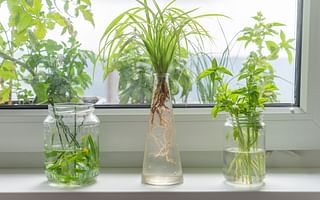Meredith Hyatt is a passionate succulent grower with over a decade's experience in nurturing and propagating these resilient plants. She takes pleasure in experimenting with varying soil compositions and breeding new plants from cuttings. When she's not immersed in her succulent garden, Meredith takes to the trails for some hiking or unwinds with a good book.
Hey there! I'm Lila, and I'm here to help you understand the difference between green and red-veined succulents. Succulents come in a wide variety of colors and patterns, and the color of their leaves can tell us a lot about their health and care needs.
Green succulents, as the name suggests, have leaves that are primarily green in color. These plants typically have a higher chlorophyll content, which gives them their vibrant green hue. Green succulents are known for their ability to photosynthesize efficiently, meaning they can convert sunlight into energy more effectively. This allows them to thrive in areas with ample sunlight.
On the other hand, red-veined succulents have leaves that feature prominent red or burgundy veins. These veins can either be a deep red color or a lighter shade of pink. The red coloration is due to the presence of pigments called anthocyanins. Anthocyanins not only give the leaves their striking color, but they also act as a natural sunscreen, protecting the plant from intense sunlight.
The main difference between green and red-veined succulents lies in their light requirements. Green succulents are generally more tolerant of direct sunlight and can handle longer exposure to bright light. They are well-suited for outdoor gardens or sunny windowsills. However, they can still burn if exposed to intense sunlight for extended periods, so it's important to monitor their light exposure.
Red-veined succulents, on the other hand, are more sensitive to direct sunlight. The red pigments in their leaves act as a natural sunscreen, but they can only provide limited protection. These succulents prefer bright, indirect light or partial shade. Placing them near a window with filtered light or providing them with some shade outdoors will help prevent their leaves from getting scorched.
When it comes to care, both green and red-veined succulents have similar needs. They both require well-draining soil to prevent root rot, and they should be watered thoroughly but infrequently. Overwatering is one of the most common mistakes in succulent care, so it's important to let the soil dry out between waterings.
In terms of potting, both types of succulents can do well in a variety of containers. When choosing pots for your succulents, opt for ones with drainage holes to ensure excess water can escape. This will help prevent waterlogged soil, which can lead to root rot. You can find a wide range of suitable pots in different materials, sizes, and designs to match your personal style and the needs of your succulents.
To sum it up, the main difference between green and red-veined succulents lies in their light requirements. Green succulents can handle more direct sunlight, while red-veined succulents prefer bright, indirect light or partial shade. Remember to choose pots with drainage holes and provide well-draining soil for both types of succulents. With the right care, your succulents will thrive and bring beauty to your space. Happy succulent growing!















